Where to dig in?
You’ll find the best compost bin by matching your household size to capacity needs, choosing between tumblers for fast results or stationary bins for large volumes. Look for dual-chamber designs that let you add fresh scraps while older material finishes decomposing. Key features include built-in aeration systems, carbon filters for odor control, and pest-proof lids.
Consider stainless steel for durability or plastic for affordability, ensuring at least 1 cubic yard capacity for proper heat retention and faster breakdown of organic materials into rich soil amendment.
Top-Rated Compost Bin Models and Reviews
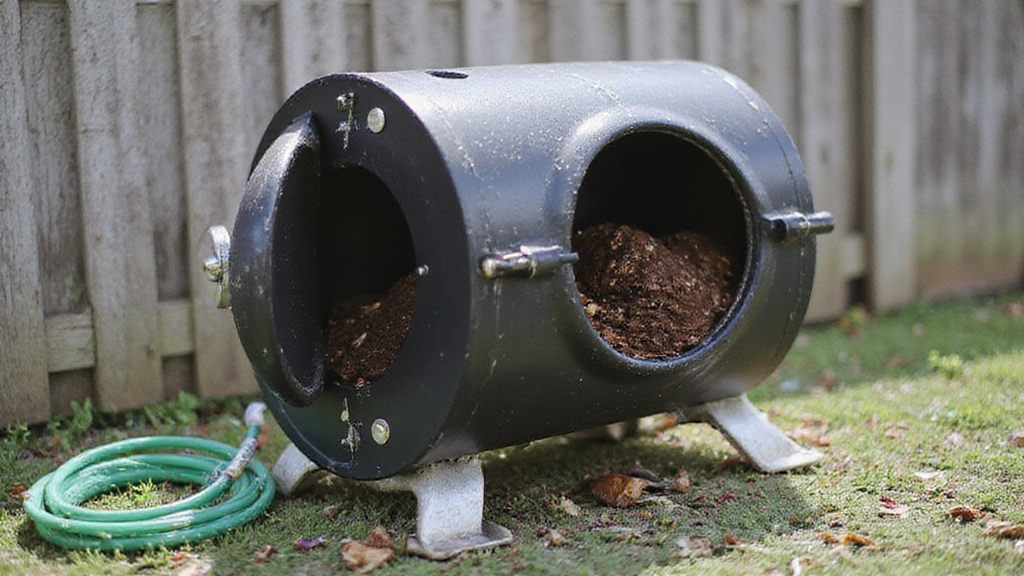
Dozens of compost bin models compete for your attention, but only a select few consistently deliver the performance and reliability you need for successful home composting.
The Black+Decker 40-Gallon Dual-Chamber Tumbling Composter stands out with its dual chambers, which means you’ll enjoy continuous composting cycles. Users consistently rate it highly for effectiveness and durability.
For larger households, the Green Johanna 330 Litre Hot Composter offers impressive capacity and eliminates pre-mixing requirements. It’s made from 100% recycled plastic, making it an eco-friendly choice.
The Hotbin Mk. 2 Composter delivers the fastest results, featuring a built-in carbon filter for odor control and a temperature gauge for monitoring progress. However, some users report accessibility challenges. Gardeners seeking top-quality tools will find that incorporating effective composting solutions complements their overall garden maintenance.
Kitchen composting enthusiasts praise the Epica Countertop Compost Bin for its charcoal filter and easy cleaning capabilities. The hinged lid design makes it easier to add scraps with both hands compared to fully removable lids.
Types of Compost Bins for Different Needs
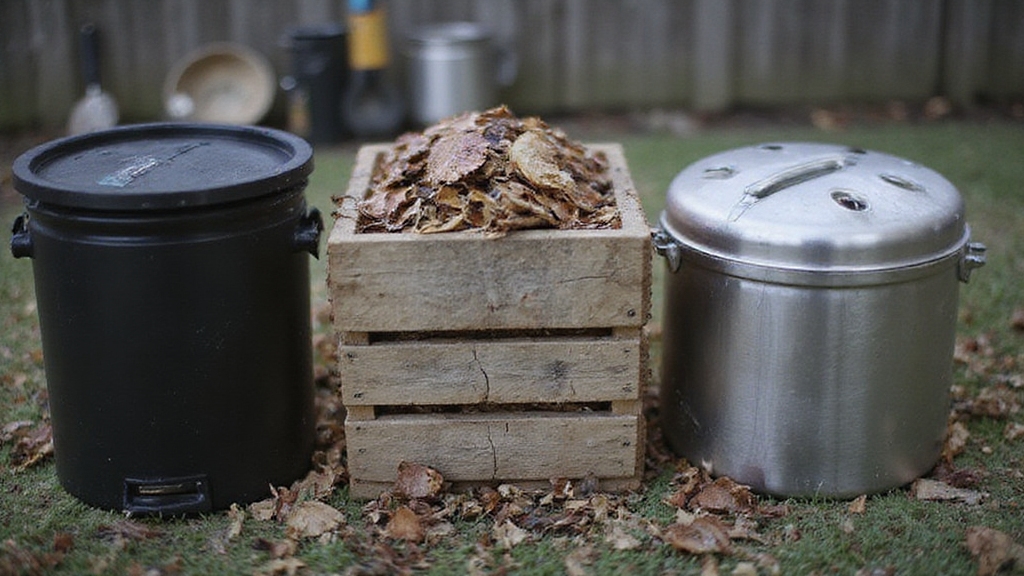
When choosing the right compost bin, you’ll need to match your selection to your specific living situation, composting goals, and available space.
Stationary bins work best for permanent garden setups where you can add materials on top, then extract finished compost from below. These wooden, plastic, or wire mesh options cost less than other types. Layering these bins with organic amendments, like worm castings, can enhance root health by providing additional nutrients.
Tumblers speed up composting through rotating drums that mix contents, reducing pests while producing compost faster. They’re pricier but more portable.
Worm composters excel in small spaces like apartments, using earthworms to create premium castings quickly. However, they need temperature protection.
Food waste processors handle kitchen scraps electrically with minimal odor, though they don’t produce traditional compost.
Insulated bins maintain heat for year-round composting in cold climates. Food waste digesters bury underground to break down 90% of waste through natural microorganisms.
Key Features to Consider When Choosing a Compost Bin
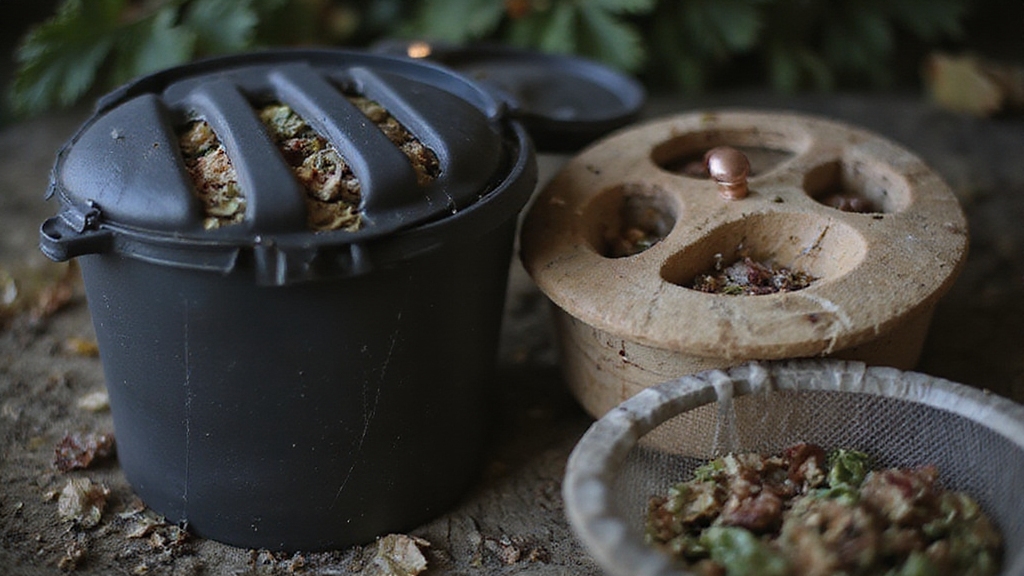
Beyond selecting the right type of compost bin for your space, you’ll need to evaluate specific features that determine how well your bin performs over time.
Accessibility Features
Look for bins with removable sides, hinged lids, and easy-grip handles. These features make adding scraps and harvesting compost much simpler. Choose bins with smooth-opening mechanisms and chunky knobs for better usability.
Performance Capabilities
Prioritize bins with excellent aeration systems and turning mechanisms. Tumblers offer superior mixing, which speeds up decomposition considerably. Ensure your bin can handle both food scraps and garden waste effectively. Incorporating biochar into your composting can further enhance its quality by improving water and nutrient retention in the decomposed material.
Odor and Maintenance Control
Select bins with charcoal filters, sealable lids, and proper ventilation to minimize smells. Look for removable liners and pest-proof designs that simplify cleaning and protect your compost from unwanted visitors. Consider bins with smooth walls for easier cleanup and maintenance.
Material Options and Durability Comparison
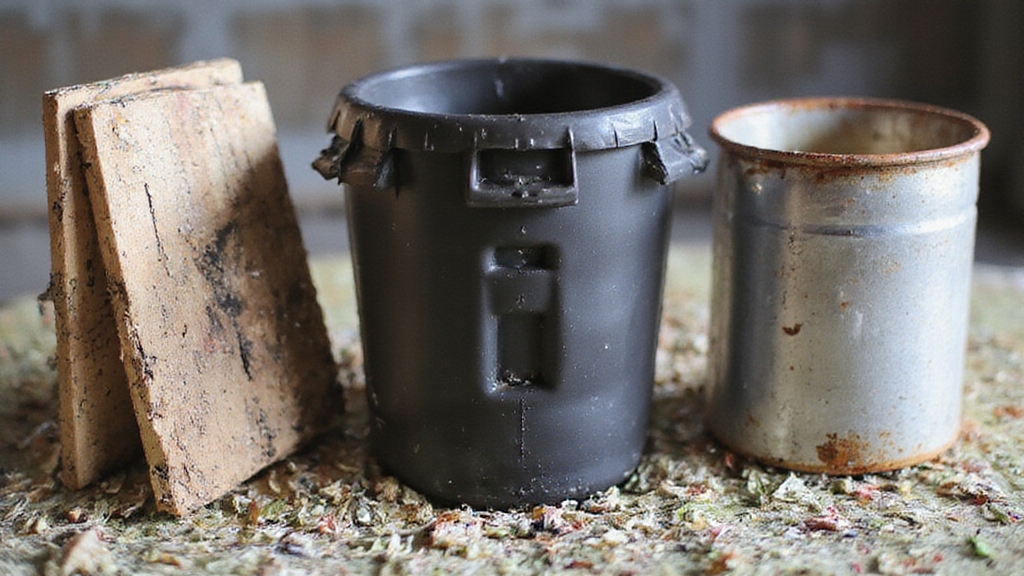
The material you choose for your compost bin directly impacts how long it’ll last, how much maintenance it requires, and how well it performs in your specific climate. Each material offers distinct advantages that you’ll want to evaluate carefully.
Wooden bins provide excellent durability, lasting up to 15 years when properly treated. The Lacewing Easy-Load Wooden Compost Bin exemplifies this longevity with its pressure-treated pine construction. However, you’ll need periodic treatments to prevent rot. Wood bins will eventually deteriorate, with the lower boards typically being the first sections to rot away over time.
- Stainless steel bins resist rust and work perfectly indoors, requiring only soap and water cleaning. For those seeking outdoor tools, weather-resistant materials are key, similar to the hoses reviewed by This Old House.
- Plastic bins offer lightweight convenience but may crack without proper maintenance over time
- Metal bins provide sturdy construction though they need regular rust prevention care
- Bamboo bins deliver eco-friendly sustainability while requiring consistent moisture control to prevent decay
Size and Capacity Guidelines for Your Space
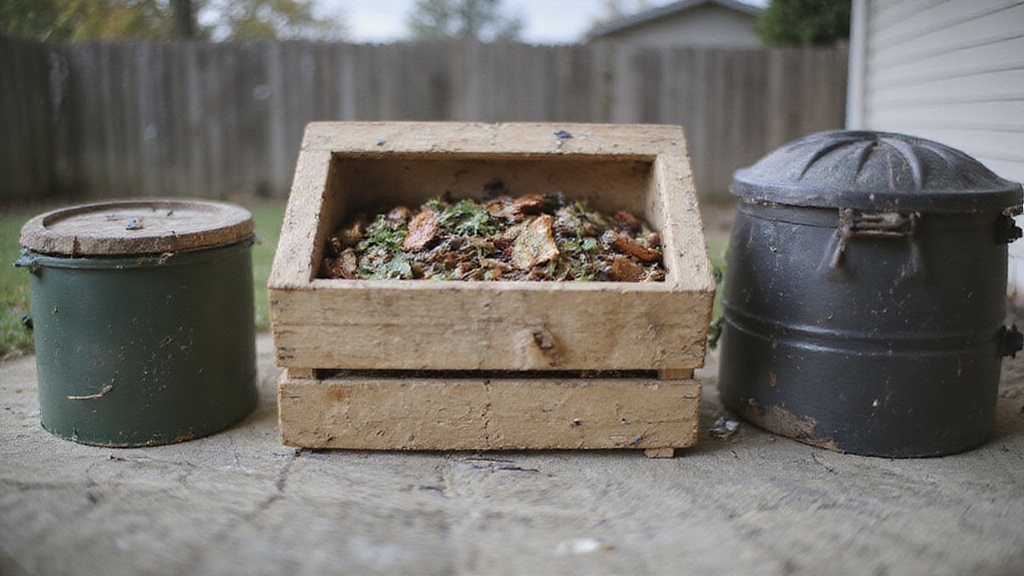
Once you’ve selected your preferred material, finding the right size becomes your next priority for successful composting. You’ll need at least 1 cubic yard (3′ x 3′ x 3′) for effective heat retention and decomposition. Smaller piles won’t generate enough heat for rapid breakdown.
For optimal results, consider a 4′ x 4′ x 4′ bin, which provides 2.4 cubic yards of capacity. This larger size improves insulation, accelerates decomposition, and accommodates turning without specialized tools. Ensuring durable performance in your compost bin, like the Master Part Heavy Duty Garden Border Digging Fork, can sustain decomposition for extended periods even under burdensome conditions.
Match your bin size to household needs: 4.5 cubic feet handles kitchen scraps for 1-4 people, while 15-20 cubic feet accommodates garden waste too. A three-bin system offers particular advantages for handling large amounts of garden waste while maintaining compost at different stages simultaneously. Guarantee you’ve got level, well-drained ground with access space around your bin for maintenance and turning materials effectively.
Odor Control and Maintenance Requirements
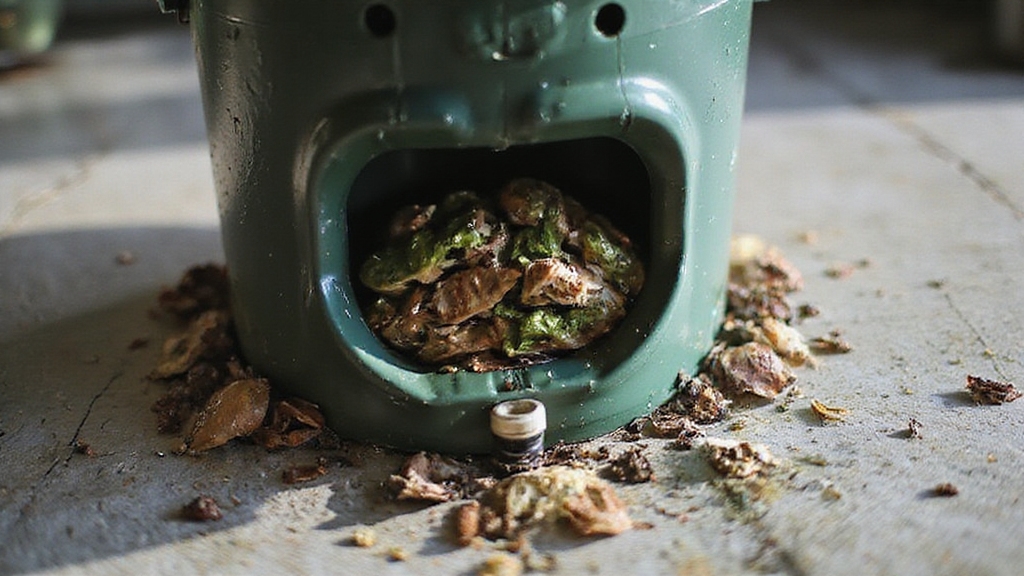
While proper sizing guarantees efficient decomposition, maintaining odor-free composting requires consistent attention to material balance and airflow regulation. You’ll need to balance nitrogen-rich greens with carbon-rich browns like newspaper, cardboard, and egg cartons. These brown materials absorb excess moisture and prevent the anaerobic conditions that create unpleasant smells. Consider incorporating natural solutions such as horticultural vinegar for added odor control, as it is an organic option.
Turn your compost pile regularly to introduce oxygen, and monitor moisture levels to keep them moderate. Your bin should have proper air intakes to maintain good airflow throughout the pile.
Essential maintenance tasks include:
- Weekly turning to expose materials to oxygen and prevent anaerobic decomposition
- Temperature monitoring to ensure your pile reaches 100-140°F for optimal breakdown
- Moisture checks to maintain proper balance without oversaturation
- Material sizing by chopping scraps into smaller pieces for faster decomposition
Never add meat or dairy products to your compost bin, as these materials will rot and create persistent odor problems that require immediate removal.
Environmental Benefits of Composting at Home
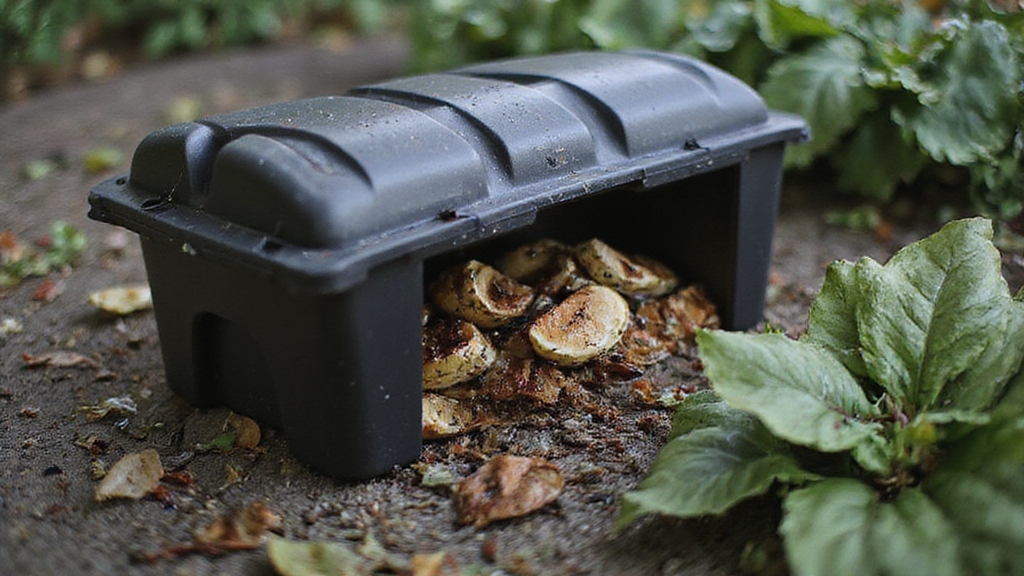
Home composting transforms your kitchen scraps and yard waste into a powerful tool for environmental protection. You’ll reduce methane emissions from landfills by more than 50%, since organic waste breaks down naturally instead of creating harmful gases in oxygen-starved landfills. Incorporating indoor plants like Philodendron, which are known for their air-purifying qualities, alongside composting can enhance the environmental benefits by further improving air quality in your home.
Your composting efforts decrease the amount of waste requiring transportation and disposal. This reduction saves energy and cuts air pollution from garbage trucks. You’re also creating a carbon sink, as finished compost stores carbon in the soil for years.
When you use homemade compost, you’ll need fewer synthetic fertilizers, which require significant energy to produce. Your improved soil retains water better, reducing irrigation needs. Plus, healthier soil supports stronger plant growth, contributing to biodiversity conservation in your local ecosystem. Home composting addresses the critical issue of food loss and waste, which generates 8-10% of global greenhouse gas emissions annually.
Setup and Usage Tips for Optimal Results
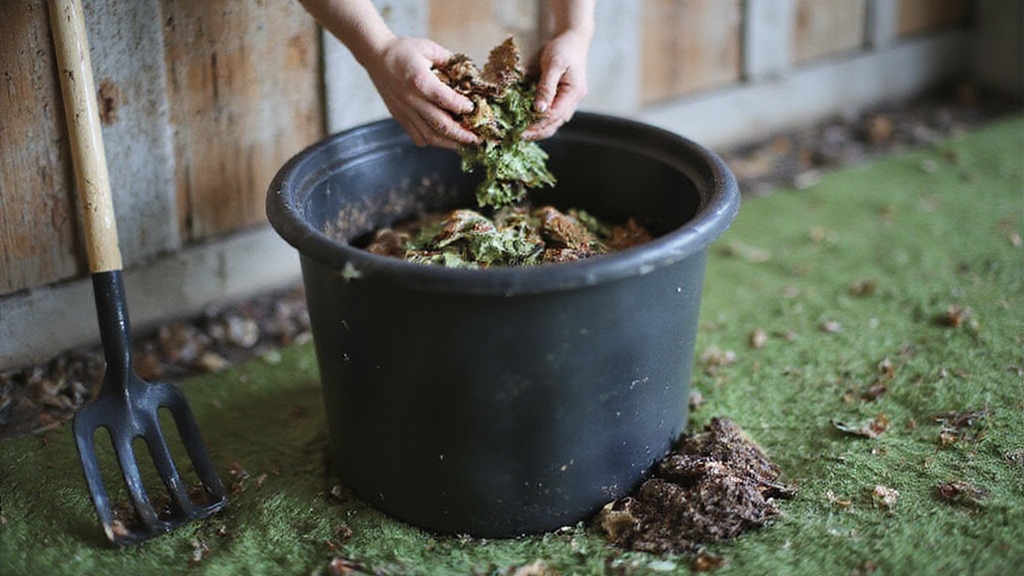
Getting the most from your compost bin starts with proper setup and consistent maintenance practices. Choose a well-drained location that’s easily accessible for regular monitoring, guaranteeing it’s at least 20 feet from buildings. Position your bin where it receives adequate sunlight but has some shade protection to prevent overheating. Understanding the composition of loamy soil can also aid in creating nutrient-rich compost for your garden.
For ideal composting results, follow these essential practices:
- Layer brown materials (dry leaves, straw) with green materials (grass clippings, vegetable scraps) to maintain proper carbon-to-nitrogen ratios
- Turn your compost regularly to ensure proper oxygenation and faster decomposition
- Monitor moisture levels, keeping contents damp like a wrung-out sponge
- Exclude meat, bones, and pet waste to prevent pests and unpleasant odors
Regular temperature checks help guarantee your pile reaches optimal decomposition levels. For best results with hot composting, ensure your pile meets the 4x4x4 feet optimal size requirement to generate and maintain proper heat levels.
Frequently Asked Questions
Can I Compost Meat and Dairy Products in My Bin?
You shouldn’t compost meat and dairy products in your home bin. These materials attract pests, create strong odors, and can harbor dangerous bacteria like Salmonella and E. coli.
They’ll also slow down your composting process and may violate local regulations. Instead, stick to vegetable scraps, fruit peels, and yard waste. Consider specialized facilities for meat disposal, or try rendering if available in your area.
How Long Does It Take to Produce Usable Compost?
You’ll produce usable compost in different timeframes depending on your method. Hot composting creates finished compost in 6-8 weeks, but you’ll need several more months for proper maturation.
Cool composting takes much longer, requiring 1-2 years before it’s ready. Your compost needs additional curing time after initial decomposition to eliminate pathogens and stabilize nutrients for safe garden use.
What Should I Do if My Compost Bin Attracts Pests?
If your compost attracts pests, first remove any food scraps like pet food or meat that shouldn’t be there. Turn your pile regularly to maintain hot temperatures, which kill pest eggs.
Add wire mesh around your bin and guarantee you’ve got a tight-fitting lid. Sprinkle diatomaceous earth on crawling insects, maintain proper carbon-to-nitrogen ratios, and inspect weekly for signs.
Can I Use Compost Bins During Winter Months?
You can absolutely use compost bins during winter months with proper preparation.
Choose wide, insulated bins and place them in south-facing locations to capture sunlight. Cover your bin to prevent excess moisture from snow. Consider heated electric bins for consistent temperatures, or try indoor vermicomposting with worms.
Reduce turning frequency during extreme cold, and maintain your brown-to-green material balance for successful winter composting.
How Much Does a Quality Compost Bin Typically Cost?
You’ll typically spend $28-60 for a quality compost bin that meets most household needs. Excellent options like the Utopia Kitchen Stainless Steel model cost just $28, while the Earth Machine offers great value at $60.
If you’re wanting premium wooden bins with advanced features, expect to invest $110-260.
Small kitchen countertop bins range $10-33, making composting accessible for any budget or living situation.
Conclusion
You’re now equipped with the knowledge to select the perfect compost bin for your home. Start by evaluating your space, choosing the right material, and considering your composting goals. Remember, you’ll create nutrient-rich soil while reducing household waste. Take action today by measuring your available area, reviewing our top recommendations, and making your purchase. Your garden will thank you, and you’ll feel proud knowing you’re helping the environment.

